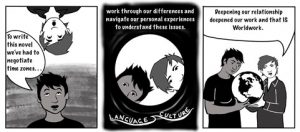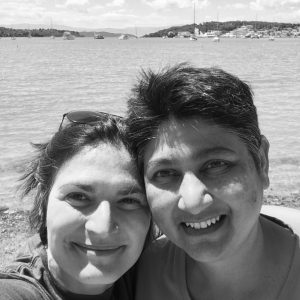A Process Oriented Approach to Collaboration
Collaboration is an alchemical way of growing an idea and ourselves. It’s kind of magical and difficult to put into words. Just like a baby, an idea needs a lot of space and time to grow. It is important not to rush. In writing our graphic novel “Dreaming Into Community, A Guidebook to Worldwork”, we spent almost a year on the first chapter alone. As we worked out our process of interacting and working together, the last chapter easily flowed over an intense 2 weeks. It took us 3 years to complete the book.
by Venetia Bouronikou and Lynn Lobo
We have often wondered if the idea for the book found us or if the idea came from our relationship. Our excitement in sharing ideas and thoughts with each other, offering mutual support, encouragement and play, as well as sharing responsibility were key to us working together. While the essence of our relationship guided our graphic novel in CR, our novel was like a container for our relationship.
Collaboration is a process, a journey into the unknown. It’s about working and dreaming together into something bigger and more complex than individual thinking. When we all first begin, not knowing how to start can often make us feel shy or uncomfortable. From another more playful viewpoint, dreaming is giving us a field full of potential. We approach with openness for an unknown adventure. But we also need to cultivate an openness for processing difficulties, while being willing to change and grow.
When working with a process we ask “what is trying to happen?”, “what is emerging here?”. We follow tendencies, subtle signals or flirts. We enrich them and let them grow bigger into existence. Integrating thoughts and expressions that one may not identify with certainly isn’t an easy task. Our individual edges as well as our differences in relationship are confronting. Curiosity and patience is needed in exploring new spaces and parts of ourselves.
Speaking personally, facing our edges in our collaboration inevitably lead to hotspots. When that happened, and it did, we focused on caring for our relationship. Conflict can be the juiciest part in a collaboration. It’s a rich place for ideas to deepen and relationships to grow. We trusted the wisdom of our process.
Our personal edges and cultural differences meant we had to slow down and attend to the irritations. Not skipping over the difficulties enabled us to flow better in our work. We learned that personal identities and edges matter. While we are individuals, we also exist within the relationship and in different cultures. Some edges can be negotiated, some edges need time, and some edges don’t need to be crossed. We learned to honor them, explore them and to cross them while respecting our differences.
(From DREAMING INTO COMMUNITY: A Guide Book to World Work, by Venetia Bouronikou and Lynn Lobo)
Giving and receiving feedback is another important aspect of collaboration, with special attention paid to edges. Giving feedback with love and kindness is a practice. Receiving feedback openly and sitting with our individual inner responses also takes practice. Sometimes it is essential to get a little distance from the work and from each other. Self care and getting clear about your particular needs that enable you to hear, is critical. Some innerwork to prepare also helps. You may need to speak for your point of view with more clarity. We are at the heart of vulnerability and patience is needed. Working with feedback can be a slow process as we are serving our dreams up to consensus reality.
So if not with trouble, then when does collaboration end? The obvious answer is when the task is complete, but this may be temporary. It may be a stepping stone to a new phase, or we may be waiting for a new idea to arrive. The relationship may have more to offer. Through deepening relationship, new ideas can emerge from its essence.
Finally, during these 3 years of our collaboration, we often wondered “why do we keep trying and struggling?”, “Wouldn’t it be better to work each one of us on our own?”. The answer we came up with repeatedly is YO (Yes and No)! Sometimes it could have been easier, true. But collaborating was always a richer experience. Collaboration is a personal and collective challenge to stay open and create a more inclusive world. It’s a social practice for living together on a shared planet.
by Venetia Bouronikou, MAPW, Dipl. PW, and Lynn Lobo, MAPW, Dipl. PW
Venetua Bouronikou is a psychologist and a certified processworker. She has 20 years of experience as a therapist and a group facilitator and trainer. She is passionate about Worldwork and the interconnectedness of personal and social change. Venetia loves big trees and deep blue waters.
You can contact Venetia here
Lynn Lobo is a certified Processworker and visual artist. Passionate about Worldwork, they offer workshops worldwide on creative practice, climate change and racism. Lynn is also a member of faculty at the Process Work Institute. They spend most of their time painting in their studio and talking to trees in the Australian bush.
You can contact Lynn here, and see their artwork here: lynnlobo.com
You can view and purchase Lynn and Venetia’s book here: DREAMING INTO COMMUNITY: A Guide Book to World Work or at amazon.com


